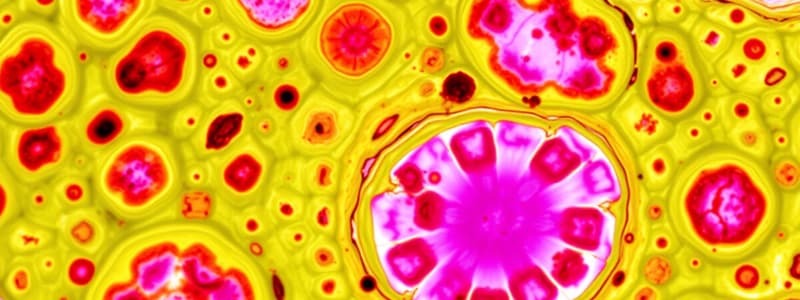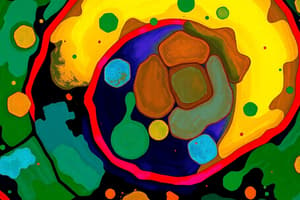Podcast
Questions and Answers
Which type of tissue is primarily responsible for movement in the body?
Which type of tissue is primarily responsible for movement in the body?
- Epithelial tissue
- Muscle tissue (correct)
- Connective tissue
- Nervous tissue
What is the primary characteristic that distinguishes connective tissue from other tissue types?
What is the primary characteristic that distinguishes connective tissue from other tissue types?
- It includes an extracellular matrix. (correct)
- It is composed of tightly packed cells.
- It primarily conducts electrical impulses.
- It only forms the skin's outer layer.
Which classification of epithelial tissue is characterized by a single layer of flat cells?
Which classification of epithelial tissue is characterized by a single layer of flat cells?
- Simple cuboidal
- Simple squamous (correct)
- Pseudostratified columnar
- Stratified squamous
What type of muscle tissue is found in the walls of the heart?
What type of muscle tissue is found in the walls of the heart?
Which of the following is NOT a type of connective tissue?
Which of the following is NOT a type of connective tissue?
What type of cells make up nervous tissue?
What type of cells make up nervous tissue?
Which type of epithelial tissue consists of multiple cell layers for protection?
Which type of epithelial tissue consists of multiple cell layers for protection?
Flashcards are hidden until you start studying
Study Notes
Levels of Biological Organization
- Biological organization ranges from the lowest level (chemical) to the highest level (biosphere).
- Levels include: chemical, organelle, cell, tissue, organ, organ system, organism, population, community, ecosystem, and biosphere.
Types of Animal Tissue
- Four primary types of animal tissue: epithelial, connective, muscle, and nervous tissue.
- Each tissue type has distinct structures and functions.
Epithelial Tissue
- Composed of tightly packed cells that cover, line, and protect body surfaces.
- Classification types based on:
- Cell arrangement:
- Simple (single layer)
- Stratified (multiple layers)
- Pseudostratified (appears layered but is not)
- Cell shape:
- Squamous (flat)
- Cuboidal (cube-shaped)
- Columnar (column-shaped)
- Cell arrangement:
Connective Tissue
- Composed of various cells and an extracellular matrix that connects, protects, and supports different body parts.
- Types of connective tissue include:
- Bone
- Cartilage
- Dense connective tissue
- Loose connective tissue
- Blood
Muscular Tissue
- Made of highly specialized muscle cells responsible for contraction and movement.
- Three types of muscular tissue:
- Skeletal muscle (voluntary, striated)
- Cardiac muscle (involuntary, striated)
- Smooth muscle (involuntary, non-striated)
Nervous Tissue
- Composed of neurons that transmit electrochemical signals.
- Contains supporting cells known as glial cells, which provide support, protection, and insulation for neurons.
Studying That Suits You
Use AI to generate personalized quizzes and flashcards to suit your learning preferences.





